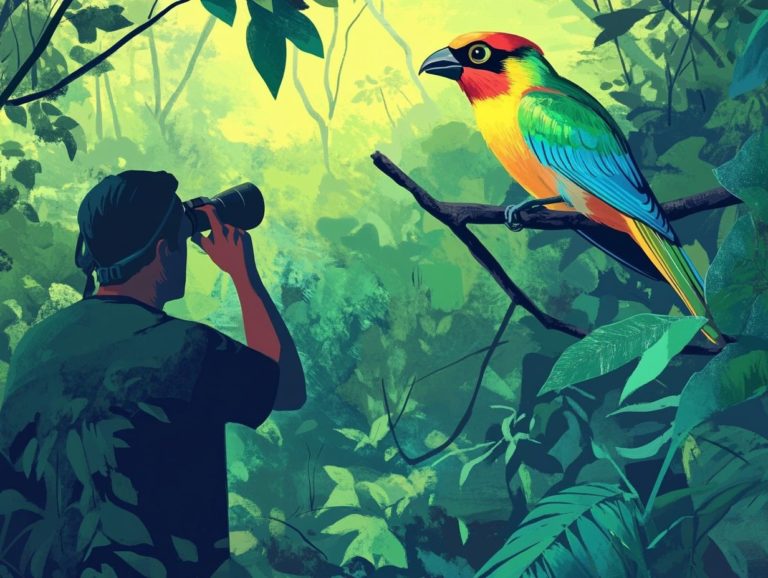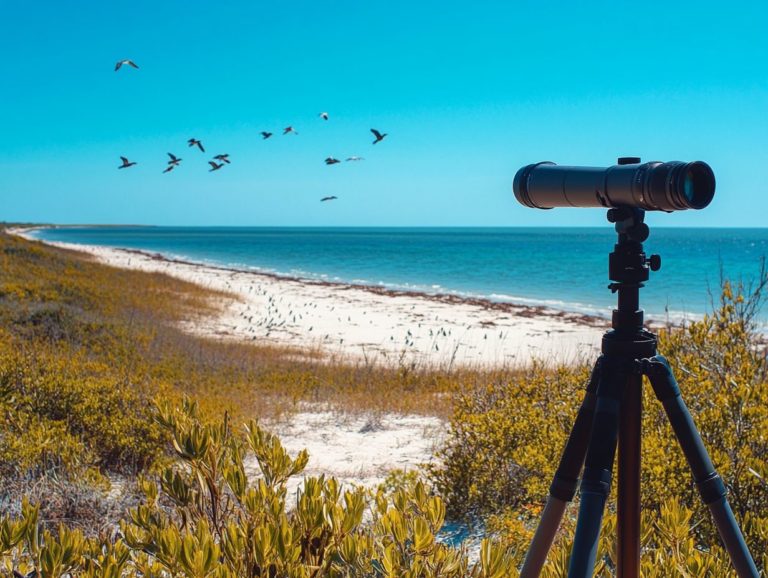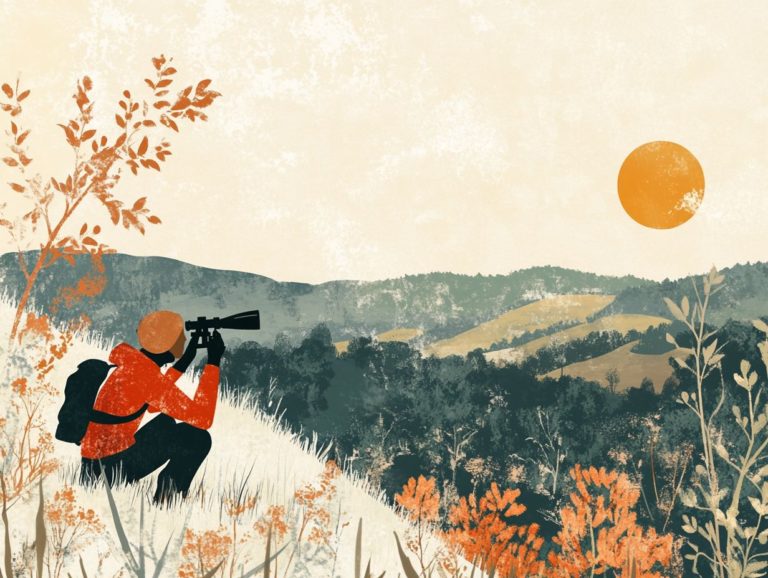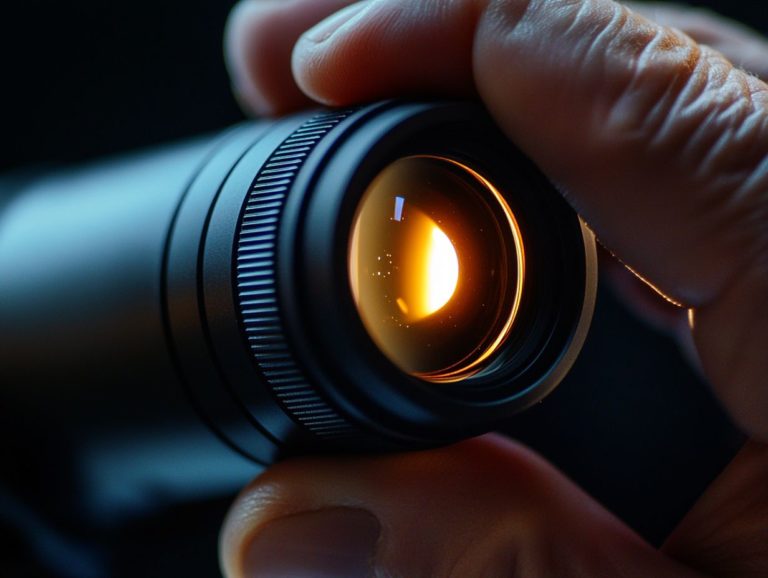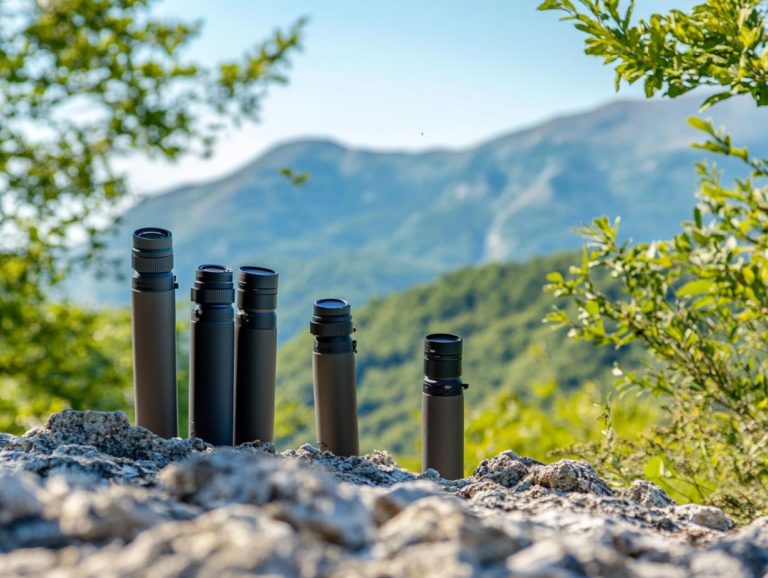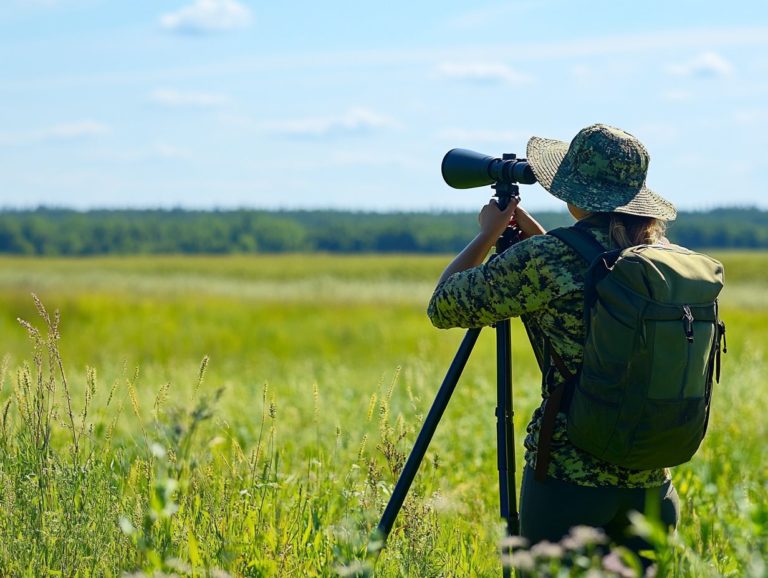5 Things Every Bird Watcher Should Know About Scopes
Bird watching unveils a realm of wonder. Equipping yourself with the right tools can significantly enhance your experience.
This guide delves into the essential facets of bird watching scopes, from the diverse types available to the key features that elevate your viewing. You ll discover the importance of magnification, lens size, and the best practices for setting up your scope to achieve optimal performance.
You ll also find maintenance tips, common pitfalls to steer clear of, and recommendations for scope reviews of top brands and models.
Whether you’re just starting out or a seasoned birder, this information will empower you to fully enjoy your bird watching adventures.
Contents
- Key Takeaways:
- 1. Types of Scopes Available for Bird Watching
- 2. Features to Look for in a Bird Watching Scope
- 3. Understanding Magnification and Lens Size
- 4. How to Properly Set Up and Use a Scope
- 5. Tips for Maintaining and Cleaning Your Scope
- What Are the Benefits of Using a Scope for Bird Watching?
- What Are the Common Mistakes to Avoid When Using a spotting scope?
- How Can a Scope Enhance Your Bird Watching Experience?
- What Are the Key Differences between Scopes and Binoculars for Bird Watching?
- What Are the Best Brands and Models of Scopes for Bird Watching?
- What Are the Essential Accessories for a Bird Watching Scope?
- Frequently Asked Questions
- What is the purpose of a scope for bird watching?
- What are the key features to look for in a bird watching scope?
- Is a scope necessary for bird watching or can binoculars suffice?
- Are there different types of scopes for bird watching?
- Do I need to spend a lot of money on a scope for bird watching?
- How do I care for and maintain my bird watching scope?
Key Takeaways:
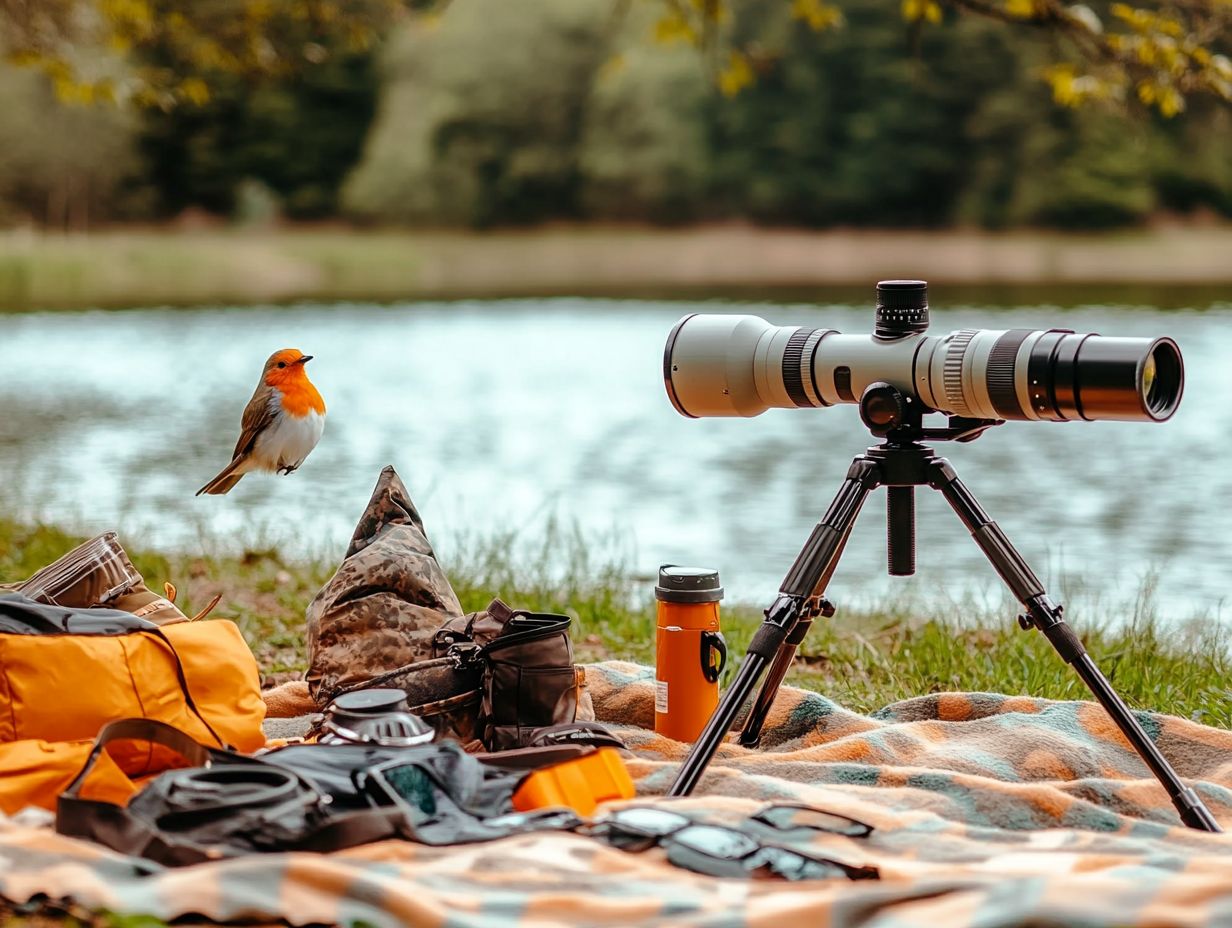
- Choose the right scope for your needs.
- Consider features like waterproofing and stabilization.
- Set up and maintain your scope properly.
1. Types of Scopes Available for Bird Watching
When you start your bird watching journey, selecting the right optical device is essential. Spotting scopes come in a variety of styles tailored to meet diverse needs and preferences, and there are ways to enhance your spotting scope experience, elevating your overall birding enjoyment.
Whether you opt for a straight eyepiece model for quick target acquisition or an angled eyepiece that offers a more comfortable viewing angle, you ll find plenty of options to choose from. Lightweight scopes are perfect for easy transport, while premium brands like Celestron and Vortex provide high-quality optics specifically designed for nature observation.
Choosing a spotting scope goes beyond mere aesthetics; the optical quality is important, influencing the clarity and detail you observe in distant birds. For example, Celestron’s line often features superior lens coatings that enhance light transmission, delivering vibrant colors and sharp images even in low-light conditions. Conversely, Vortex offers rugged, durable scopes that stand up to harsh weather while providing impressive resolution.
As a bird watcher seeking to capture the beauty of various species, investing in a high-performance scope will undoubtedly pay dividends in both the depth of view and your overall satisfaction during wildlife viewing. To enhance your knowledge, check out these 5 things you didn’t know about spotting scopes.
2. Features to Look for in a Bird Watching Scope
When you’re selecting a bird watching scope, it’s crucial to grasp the key features that elevate your viewing experience. Think about magnification, objective lens diameter, and the various eyepiece styles that cater to your unique preferences and birding scenarios. You might also be surprised by 5 weird facts about spotting scopes that can enhance your knowledge.
In addition to these aspects, explore magnification levels typically ranging from 20x to 60x. This range significantly enhances the clarity and detail of those distant birds you re eager to observe. The objective lens diameter, referring to the width of the lens at the front of the scope, is equally important; a larger diameter improves light-gathering ability, shining in low-light conditions while expanding your field of view (FOV) for a broader perspective of your surroundings.
Don t overlook waterproof properties, as they are vital for durability in unpredictable weather, allowing you to enjoy bird watching regardless of the conditions. Advanced lens coatings can remarkably enhance image sharpness by reducing glare and improving contrast, making those long bird watching sessions far more comfortable and enjoyable without leaving you with unnecessary eye strain.
3. Understanding Magnification and Lens Size
Understanding magnification and lens size is essential for birdwatching. These elements impact image quality and brightness, affecting your overall viewing experience.
When choosing binoculars or scopes, magnification dictates how far away you can observe birds clearly. Higher magnification helps spot distant birds but may narrow your viewing area and make images appear shaky.
The lens diameter is also crucial. A larger lens gathers more light, improving image brightness in low light conditions.
Don’t overlook the exit pupil and eye relief. These specs ensure comfort during long viewing sessions, helping you avoid fatigue.
Popular magnification levels like 8x or 10x strike a balance between distance and image stability. They are perfect for both novice and seasoned birdwatchers.
4. How to Properly Set Up and Use a Scope
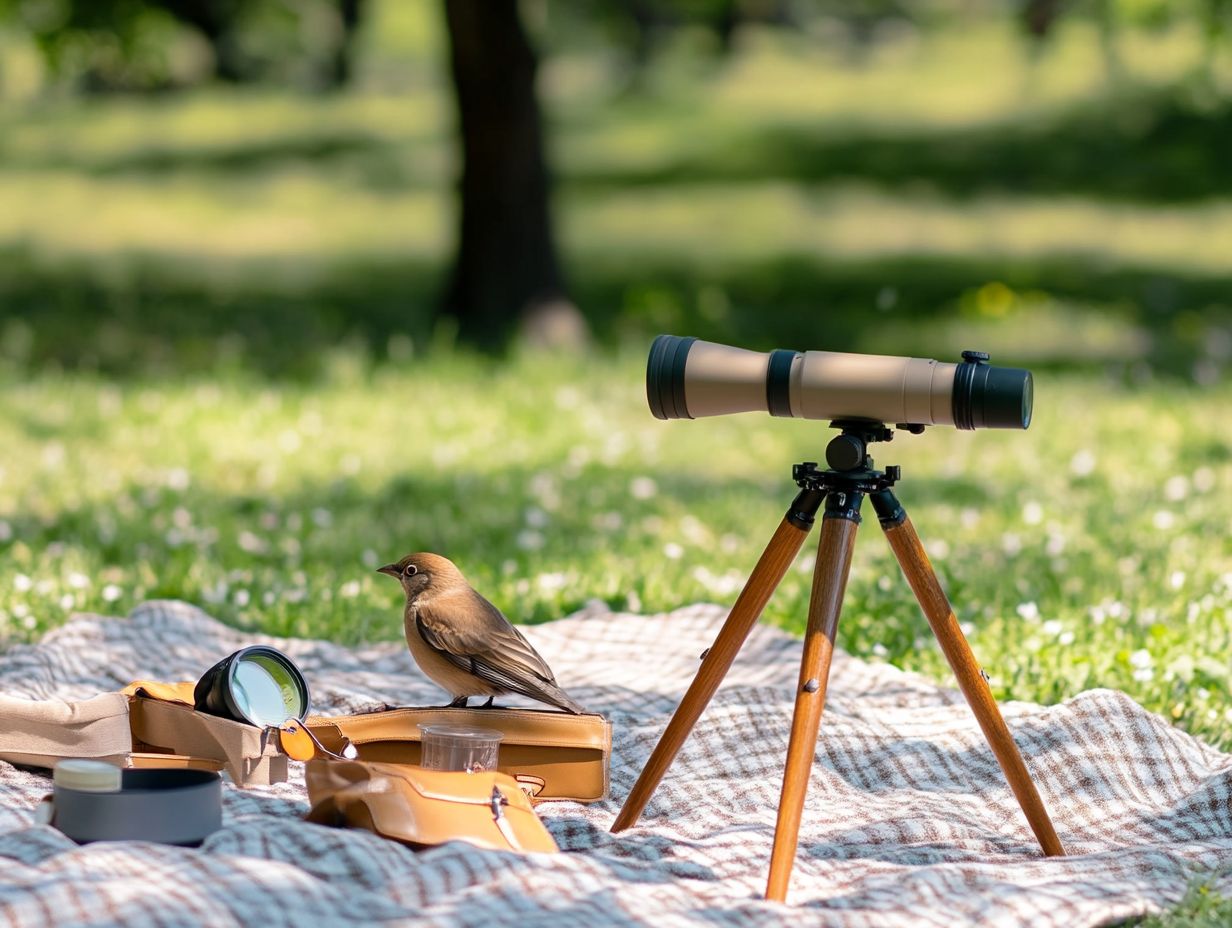
Setting up a spotting scope involves crucial steps that enhance your birding experience. Ensure tripod stability, understand the scope’s features, and consider using top features in bird watching binoculars as well as accessories like a digiscoping adapter.
-
Select a sturdy tripod that is height adjustable and stable in windy conditions. For uneven terrain, extend one leg slightly to level the tripod for precise viewing.
-
Familiarize yourself with the scope’s optical features. Learn how to use the zoom and focus settings for clear images. If you re new, align the scope with a fixed point and adjust the eyepiece for comfort.
-
A digiscoping adapter can turn your scope into a photography tool. Capture stunning wildlife images up close and enrich your birdwatching experience.
5. Tips for Maintaining and Cleaning Your Scope
Maintaining and cleaning your spotting scope is vital for durability. This ensures a clear view for countless birdwatching adventures.
Regular tasks include checking waterproof seals and examining lens coatings for wear. These steps are crucial to keep your scope performing well.
To keep the lenses in great condition, use a soft brush or blower to remove dust. Then, apply lens cleaner to a microfiber cloth and gently wipe the glass in a circular motion.
Using the right tools prevents damage to your optical components. This ensures every detail of your outdoor experience remains sharp and vivid.
What Are the Benefits of Using a Scope for Bird Watching?
A spotting scope enhances birdwatching in many ways. You ll enjoy improved image brightness and clarity, allowing you to observe wildlife from a distance without disturbing them.
High-quality optics allow you to see intricate feather patterns and subtle color variations. Imagine spotting a rare warbler perched high in a tree, its vibrant colors clear.
This capability shines in diverse environments. Whether scanning a dense forest or a sprawling wetland, both beginners and experts appreciate the clarity of advanced lens technology.
Ultimately, spotting scopes elevate your birdwatching experience, turning casual observations into unforgettable moments of discovery.
What Are the Common Mistakes to Avoid When Using a spotting scope?
Many birdwatchers find themselves struggling with common mistakes when using spotting scopes. To enhance your experience, consider these 5 tips for spotting birds with a scope, which can help prevent errors that seriously detract from their viewing experience.
Issues often stem from user comfort and tripod stability. Improper tripod use frequently leads to shaky images, making it a challenge to focus on elusive birds. Poor positioning adds to your frustration; if you re not set up at the right angle, you might end up contorting your body in uncomfortable ways, impacting your enjoyment of the experience.
Neglecting eye relief the distance between your eye and the eyepiece of the scope can result in a less-than-ideal sight picture. To address these challenges, invest in a sturdy tripod, adjust its height to fit your specific needs, and ensure the eyepiece of the scope is comfortably distanced from your eyes.
By taking these simple precautions regarding comfort and tripod compatibility, you can significantly enhance your overall viewing experience. This allows you to immerse yourself in the beauty of nature without distraction.
How Can a Scope Enhance Your Bird Watching Experience?
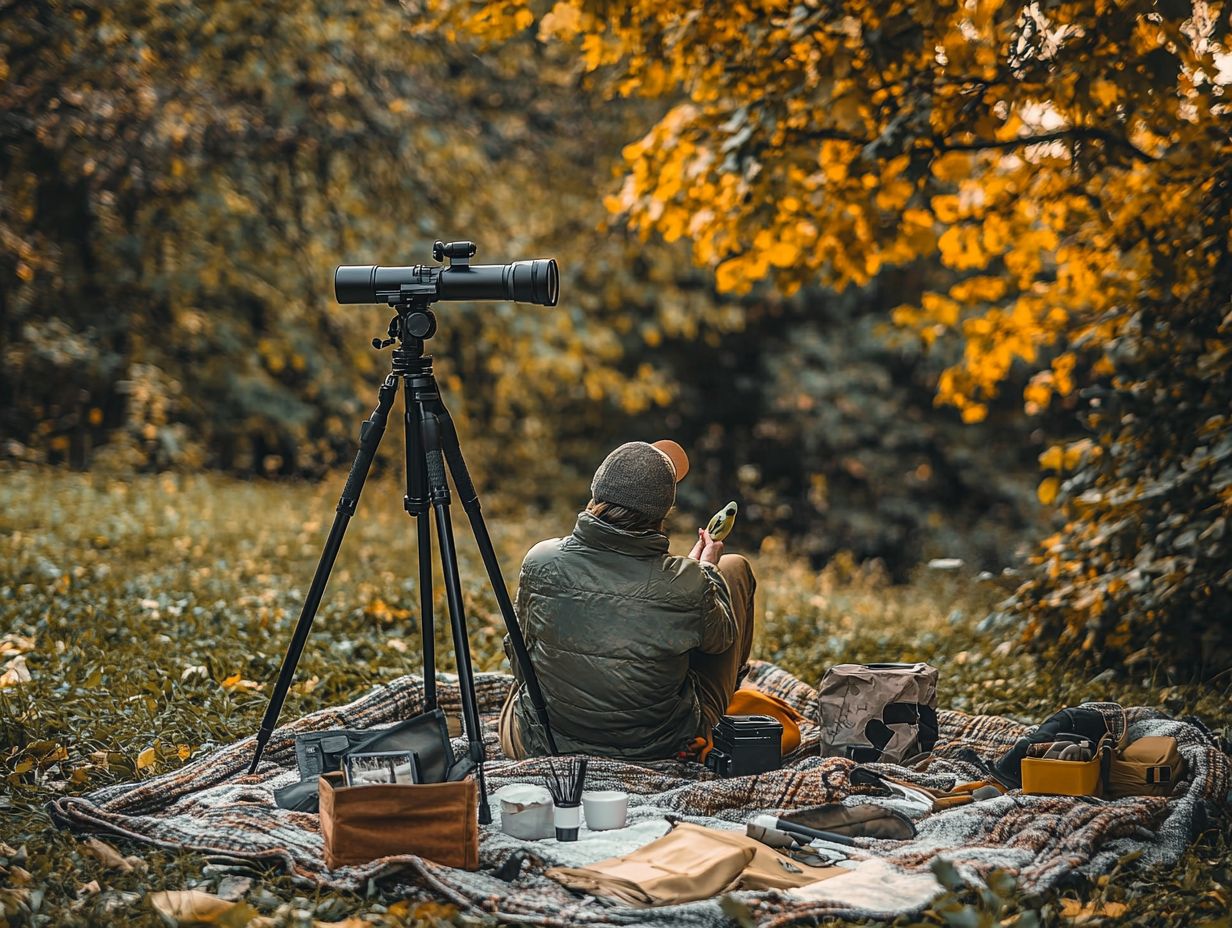
A high-quality spotting scope can elevate your birdwatching experience significantly, delivering exceptional image sharpness and brightness. With advanced features like zoom functionality, you can enjoy close-up views of distant wildlife that transform your observations into something truly extraordinary.
When scanning vast landscapes or trying to catch a glimpse of elusive species that prefer to keep their distance, this kind of clear view becomes invaluable. While binoculars may provide a broad view of fluttering wings, the spotting scope s zoom capability allows you to uncover intricate details think plumage patterns and small changes in color that you might otherwise overlook.
Imagine the thrill of spotting a hawk soaring high above! With a scope, you can discern the precise alignment of its feathers and even the expression on its face. This level of detail cultivates a deeper connection to nature, turning each outing into not just an activity, but a rich experience brimming with discovery.
What Are the Key Differences between Scopes and Binoculars for Bird Watching?
When comparing scopes and binoculars for bird watching, you’ll quickly notice the differences in optical performance, weight, and field of view. Each optical device has its own strengths, tailored to distinct birding situations and your personal preferences.
If high magnification is your priority, spotting scopes often deliver breathtakingly detailed images that reveal even the subtlest markings on a bird’s plumage. On the other hand, binoculars provide a compact and portable solution, making them ideal for quick observations when you’re on the go.
Image brightness is another critical factor. While spotting scopes shine in low light conditions, binoculars with larger objectives can certainly hold their own in various settings. Comfort is key during extended viewing sessions, where aspects like eye relief and weight become significant.
If you prefer lightweight gear for long treks, binoculars are typically the way to go, helping to minimize fatigue during prolonged use.
Don’t miss the chance to witness the beauty of nature up close! Grab your spotting scope and experience the wonders of birdwatching today!
What Are the Best Brands and Models of Scopes for Bird Watching?
Choosing the right brand and model of spotting scope for birdwatching can significantly elevate your outdoor equipment investment. Premium brands like Celestron, Vortex, and Vanguard are renowned for their high-quality optics and reliable construction, all supported by positive reviews and robust warranties.
These brands have earned their place in the hearts of the birding community thanks to their impressive features and capabilities. If you’re just starting out, the Celestron Ultima 80 is often recommended for its excellent balance of performance and affordability, offering a clear view without overwhelming beginners.
For those with a bit more experience, the Vortex Razor HD frequently garners praise for its superior light transmission and durable construction, making it perfect for extended use in diverse environments. Additionally, user reviews often highlight Vanguard’s Endeavor HD for its compact design and remarkable clarity, proving that even entry-level enthusiasts can enjoy the benefits of high-quality optics.
By understanding these insights, you can make an informed choice that will lead to an unparalleled birdwatching experience.
What Are the Essential Accessories for a Bird Watching Scope?
To truly elevate your birdwatching experience with your spotting scope, consider investing in several essential accessories. A digiscoping adapter for smartphone photography and a compatible tripod can significantly enhance your time outdoors.
A high-quality tripod is vital; it provides the stability you need for clearer views and minimizes shake during those lengthy observation sessions. Look for models that are adjustable in height and feature a smooth panning head, making it easy to track those elusive birds on the move.
Additionally, don’t overlook comfortable extras like:
- A high-density foam carrying case for effortless transport
- Lens cleaning kits to keep your optics in pristine condition
- Comfortable viewing cushions for prolonged enjoyment
These thoughtful additions will not only boost usability and comfort but also make those extended hours in the field more enjoyable and productive, ultimately enriching your entire birdwatching adventure.
Frequently Asked Questions
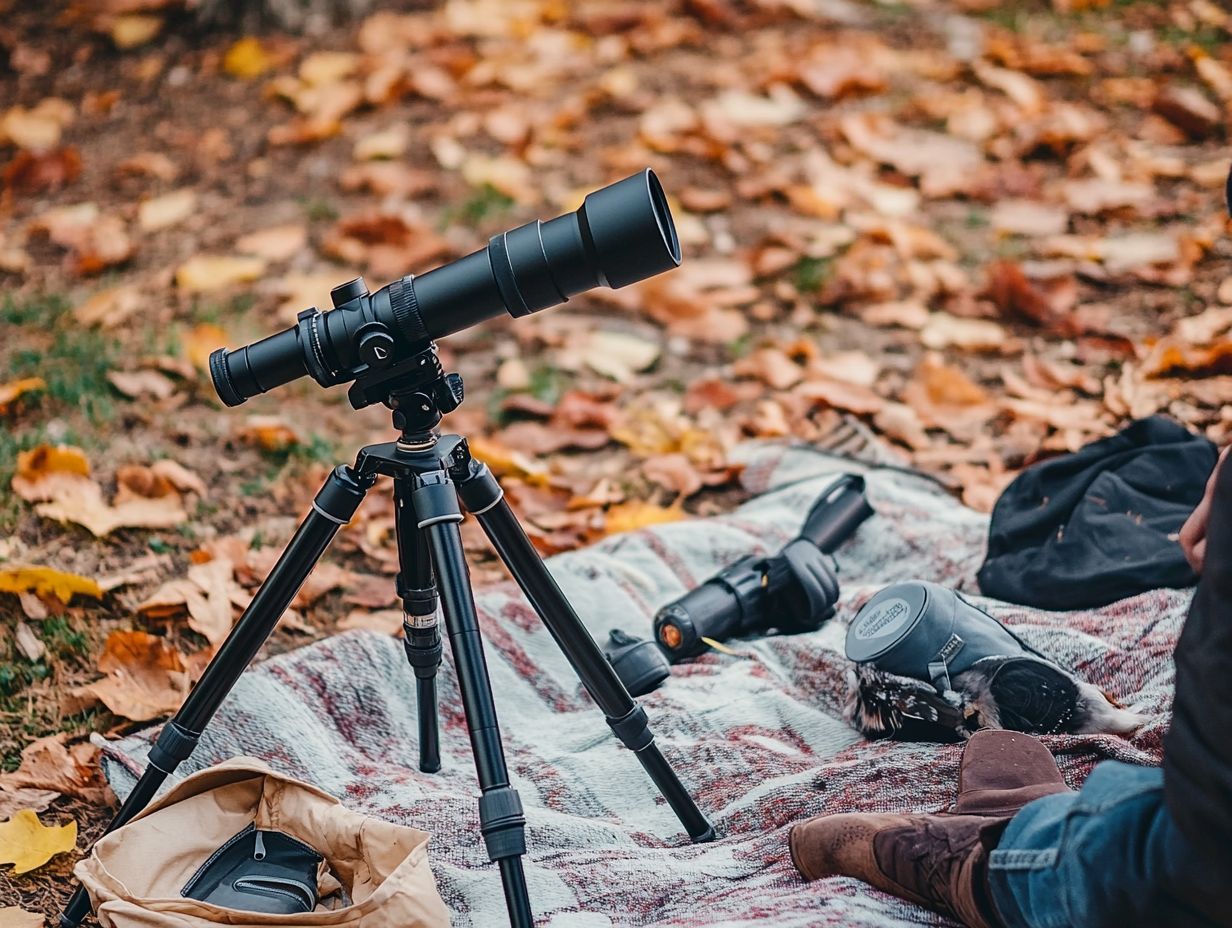
What is the purpose of a scope for bird watching?
A scope, also known as a spotting scope or telescope, is a tool used to magnify and clarify distant objects for better viewing. In bird watching, understanding the unique features in high-end spotting scopes is essential for getting a closer and more detailed look at birds in their natural habitat.
What are the key features to look for in a bird watching scope?
The first important feature to consider is magnification power, which should be between 20x to 60x for bird watching. Next, look for a scope with a large objective lens (at least 60mm) for better light gathering and a wider field of view. To enhance your experience, check out the top 5 essential accessories for bird watching, which include waterproof and fog proof capabilities, durable construction, and a quality tripod for stability.
Is a scope necessary for bird watching or can binoculars suffice?
While binoculars are a great tool for bird watching, a scope can provide much more detailed views of birds that are further away. It also allows for more precise identification of smaller birds and can make a big difference in spotting rare or elusive species.
Are there different types of scopes for bird watching?
Yes, there are two main types of scopes for bird watching – angled and straight. Angled scopes have a diagonal eyepiece for comfortable viewing at different angles, while straight scopes are better for viewing birds on the ground or at eye level. Ultimately, the type of scope you choose will depend on personal preference and the type of bird watching you do.
Do I need to spend a lot of money on a scope for bird watching?
It is possible to find a good quality scope for bird watching at a reasonable price. However, keep in mind that the more features and higher magnification power, the more expensive the scope will be. To make the most of your investment, learn how to use bird watching scopes to ensure clear and enjoyable bird watching experiences.
How do I care for and maintain my bird watching scope?
Keep your bird watching scope in the best condition by storing it in a dry and clean spot when you’re not using it. Always handle the lenses with care, using a lens cloth for cleaning.
If you use your scope in wet conditions, make sure to dry it completely before putting it away. Regularly check for loose screws and oil any moving parts as needed to keep it functioning smoothly.

